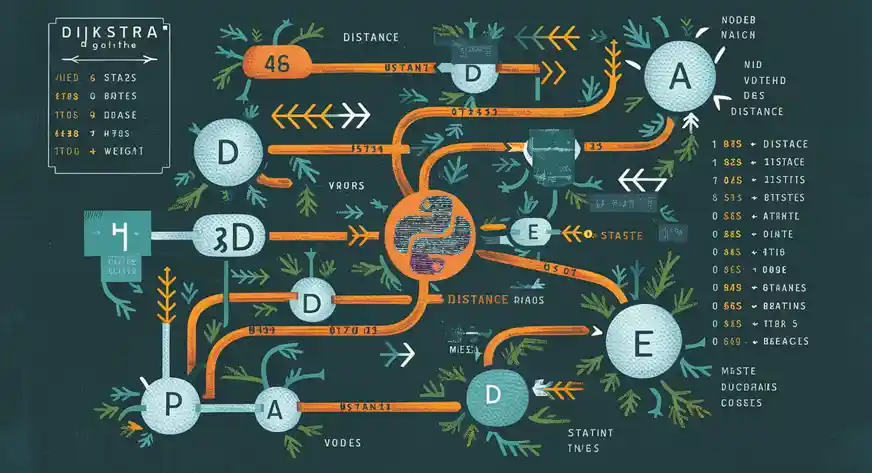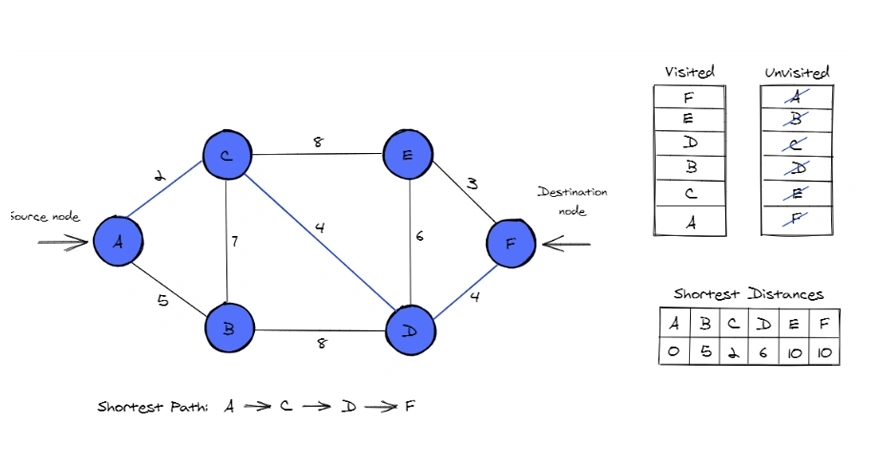Mastering Dijkstra's Algorithm in Python: Finding the Shortest Path
This tutorial guides you through implementing Dijkstra's Algorithm in Python to efficiently find the shortest paths in a weighted graph. Understanding this algorithm is crucial for various applications, from GPS navigation to network routing.

Key Learning Objectives:
- Grasp the core principles of Dijkstra's Algorithm.
- Implement Dijkstra's Algorithm effectively in Python.
- Manage weighted graphs and compute shortest paths between nodes.
- Optimize the algorithm for enhanced performance in Python.
- Apply your knowledge by solving a practical shortest path problem.
Table of Contents:
- What is Dijkstra's Algorithm?
- Fundamental Concepts of Dijkstra's Algorithm
- Implementing Dijkstra's Algorithm
- Optimizing Dijkstra's Algorithm
- Real-World Applications
- Avoiding Common Pitfalls
- Frequently Asked Questions
What is Dijkstra's Algorithm?
Dijkstra's Algorithm is a greedy algorithm that determines the shortest path from a single source node to all other nodes in a graph with non-negative edge weights. It iteratively expands the set of nodes with known shortest distances from the source, selecting the node with the minimum distance at each step.
Here's a simplified explanation:
- Assign a tentative distance to each node: 0 for the source, infinity for others.
- Mark the source node as current. Mark all other nodes as unvisited.
- For the current node, examine all unvisited neighbors. Calculate their tentative distances via the current node. If this distance is shorter than the existing tentative distance, update it.
- Mark the current node as visited.
- Select the unvisited node with the smallest tentative distance as the new current node. Repeat steps 3-5 until all nodes are visited or the shortest distance to the target node is found.
Fundamental Concepts:
- Graph Representation: Nodes and edges represent the graph. Each edge has a non-negative weight (distance or cost).
-
Priority Queue: A priority queue (like Python's
heapq) efficiently selects the node with the minimum tentative distance. - Greedy Approach: The algorithm expands the set of nodes with known shortest distances by selecting the nearest unvisited node.
Implementing Dijkstra's Algorithm:
We'll represent the graph as a dictionary: keys are nodes, values are lists of (neighbor, weight) tuples.
Step 1: Graph Initialization
graph = {
'A': [('B', 1), ('C', 4)],
'B': [('A', 1), ('C', 2), ('D', 5)],
'C': [('A', 4), ('B', 2), ('D', 1)],
'D': [('B', 5), ('C', 1)]
}
Step 2: Algorithm Implementation
import heapq
def dijkstra(graph, start):
distances = {node: float('inf') for node in graph}
distances[start] = 0
pq = [(0, start)]
while pq:
current_distance, current_node = heapq.heappop(pq)
if current_distance > distances[current_node]:
continue
for neighbor, weight in graph[current_node]:
distance = current_distance weight
if distance
<p><strong>Step 3: Running the Algorithm</strong></p>
<pre class="brush:php;toolbar:false">start_node = 'A'
shortest_paths = dijkstra(graph, start_node)
print(f"Shortest paths from {start_node}: {shortest_paths}")
Step 4: Understanding the Output
The output shows the shortest distance from the starting node ('A') to all other nodes.
Example of Dijkstra's Algorithm:

This example visually demonstrates the step-by-step process, showing how the algorithm iteratively finds the shortest paths.
Optimizing Dijkstra's Algorithm:
- Early Stopping: Stop when the target node's shortest distance is found.
- Bidirectional Search: Run Dijkstra's from both source and destination simultaneously.
- Efficient Data Structures: Use Fibonacci heaps for extremely large graphs.
Real-World Applications:
- GPS Navigation: Finding optimal routes.
- Network Routing: Determining efficient data packet paths.
- Robotics: Path planning for robots.
- Game Development: NPC pathfinding.
Avoiding Common Pitfalls:
- Negative Edge Weights: Dijkstra's doesn't work with negative weights. Use Bellman-Ford instead.
-
Inefficient Priority Queue: Use
heapqor Fibonacci heaps. - Memory Overhead: Optimize graph representation for large graphs.
Conclusion:
Dijkstra's Algorithm is a powerful tool for solving shortest path problems in graphs with non-negative weights. This tutorial provides a solid foundation for understanding and implementing this algorithm in Python.
Frequently Asked Questions:
Q1: What graph types does Dijkstra's handle? A: Graphs with non-negative edge weights.
Q2: Does it work with directed graphs? A: Yes.
Q3: Time complexity? A: O((V E) log V) with a binary heap.
Q4: Is it a greedy algorithm? A: Yes.
The above is the detailed content of Dijkstra Algorithm in Python. For more information, please follow other related articles on the PHP Chinese website!

Hot AI Tools

Undress AI Tool
Undress images for free

Undresser.AI Undress
AI-powered app for creating realistic nude photos

AI Clothes Remover
Online AI tool for removing clothes from photos.

Clothoff.io
AI clothes remover

Video Face Swap
Swap faces in any video effortlessly with our completely free AI face swap tool!

Hot Article

Hot Tools

Notepad++7.3.1
Easy-to-use and free code editor

SublimeText3 Chinese version
Chinese version, very easy to use

Zend Studio 13.0.1
Powerful PHP integrated development environment

Dreamweaver CS6
Visual web development tools

SublimeText3 Mac version
God-level code editing software (SublimeText3)

Hot Topics
 Top 7 NotebookLM Alternatives
Jun 17, 2025 pm 04:32 PM
Top 7 NotebookLM Alternatives
Jun 17, 2025 pm 04:32 PM
Google’s NotebookLM is a smart AI note-taking tool powered by Gemini 2.5, which excels at summarizing documents. However, it still has limitations in tool use, like source caps, cloud dependence, and the recent “Discover” feature
 Sam Altman Says AI Has Already Gone Past The Event Horizon But No Worries Since AGI And ASI Will Be A Gentle Singularity
Jun 12, 2025 am 11:26 AM
Sam Altman Says AI Has Already Gone Past The Event Horizon But No Worries Since AGI And ASI Will Be A Gentle Singularity
Jun 12, 2025 am 11:26 AM
Let’s dive into this.This piece analyzing a groundbreaking development in AI is part of my continuing coverage for Forbes on the evolving landscape of artificial intelligence, including unpacking and clarifying major AI advancements and complexities
 Hollywood Sues AI Firm For Copying Characters With No License
Jun 14, 2025 am 11:16 AM
Hollywood Sues AI Firm For Copying Characters With No License
Jun 14, 2025 am 11:16 AM
But what’s at stake here isn’t just retroactive damages or royalty reimbursements. According to Yelena Ambartsumian, an AI governance and IP lawyer and founder of Ambart Law PLLC, the real concern is forward-looking.“I think Disney and Universal’s ma
 Alphafold 3 Extends Modeling Capacity To More Biological Targets
Jun 11, 2025 am 11:31 AM
Alphafold 3 Extends Modeling Capacity To More Biological Targets
Jun 11, 2025 am 11:31 AM
Looking at the updates in the latest version, you’ll notice that Alphafold 3 expands its modeling capabilities to a wider range of molecular structures, such as ligands (ions or molecules with specific binding properties), other ions, and what’s refe
 What Does AI Fluency Look Like In Your Company?
Jun 14, 2025 am 11:24 AM
What Does AI Fluency Look Like In Your Company?
Jun 14, 2025 am 11:24 AM
Using AI is not the same as using it well. Many founders have discovered this through experience. What begins as a time-saving experiment often ends up creating more work. Teams end up spending hours revising AI-generated content or verifying outputs
 Dia Browser Released — With AI That Knows You Like A Friend
Jun 12, 2025 am 11:23 AM
Dia Browser Released — With AI That Knows You Like A Friend
Jun 12, 2025 am 11:23 AM
Dia is the successor to the previous short-lived browser Arc. The Browser has suspended Arc development and focused on Dia. The browser was released in beta on Wednesday and is open to all Arc members, while other users are required to be on the waiting list. Although Arc has used artificial intelligence heavily—such as integrating features such as web snippets and link previews—Dia is known as the “AI browser” that focuses almost entirely on generative AI. Dia browser feature Dia's most eye-catching feature has similarities to the controversial Recall feature in Windows 11. The browser will remember your previous activities so that you can ask for AI
 The Prototype: Space Company Voyager's Stock Soars On IPO
Jun 14, 2025 am 11:14 AM
The Prototype: Space Company Voyager's Stock Soars On IPO
Jun 14, 2025 am 11:14 AM
Space company Voyager Technologies raised close to $383 million during its IPO on Wednesday, with shares offered at $31. The firm provides a range of space-related services to both government and commercial clients, including activities aboard the In
 From Adoption To Advantage: 10 Trends Shaping Enterprise LLMs In 2025
Jun 20, 2025 am 11:13 AM
From Adoption To Advantage: 10 Trends Shaping Enterprise LLMs In 2025
Jun 20, 2025 am 11:13 AM
Here are ten compelling trends reshaping the enterprise AI landscape.Rising Financial Commitment to LLMsOrganizations are significantly increasing their investments in LLMs, with 72% expecting their spending to rise this year. Currently, nearly 40% a






